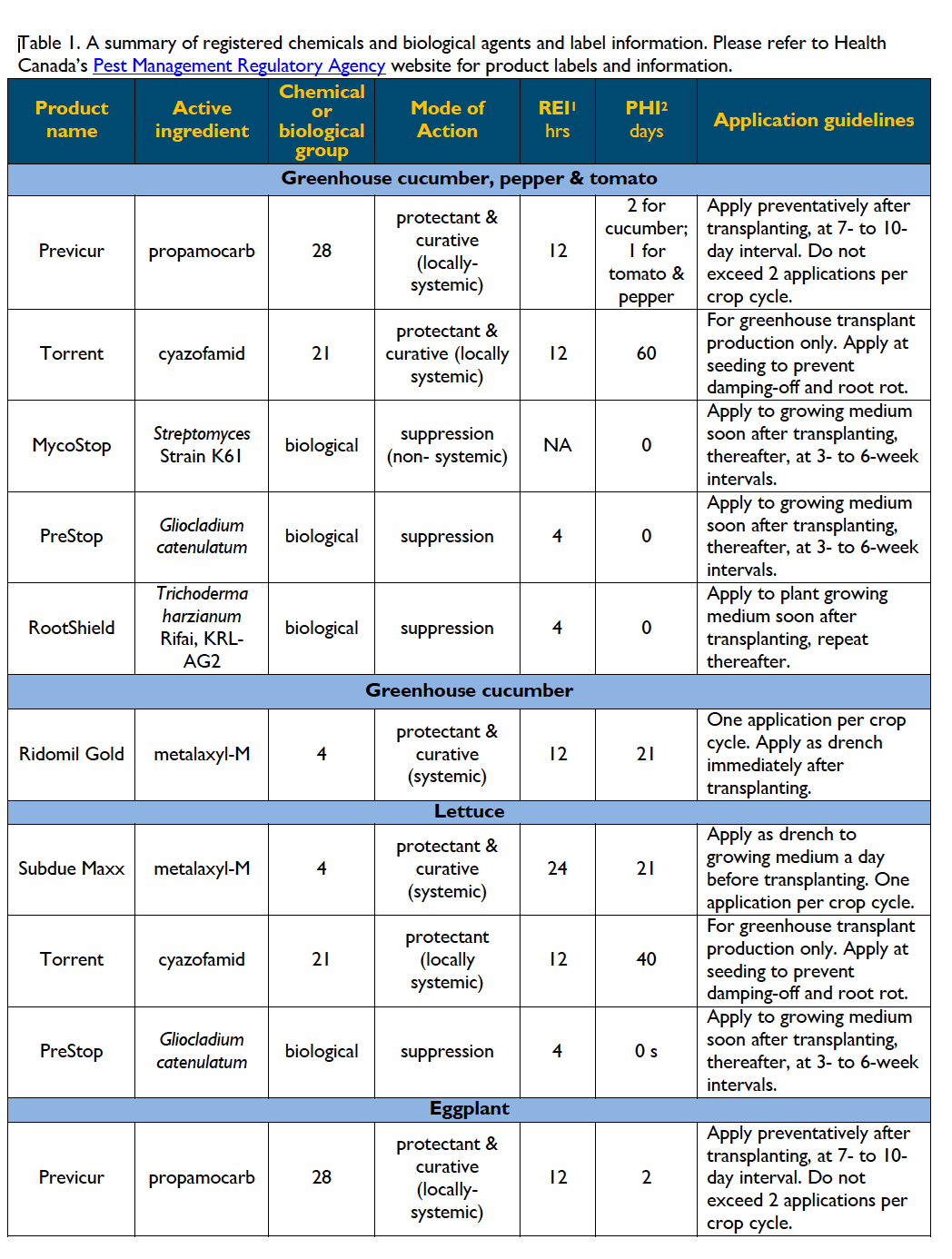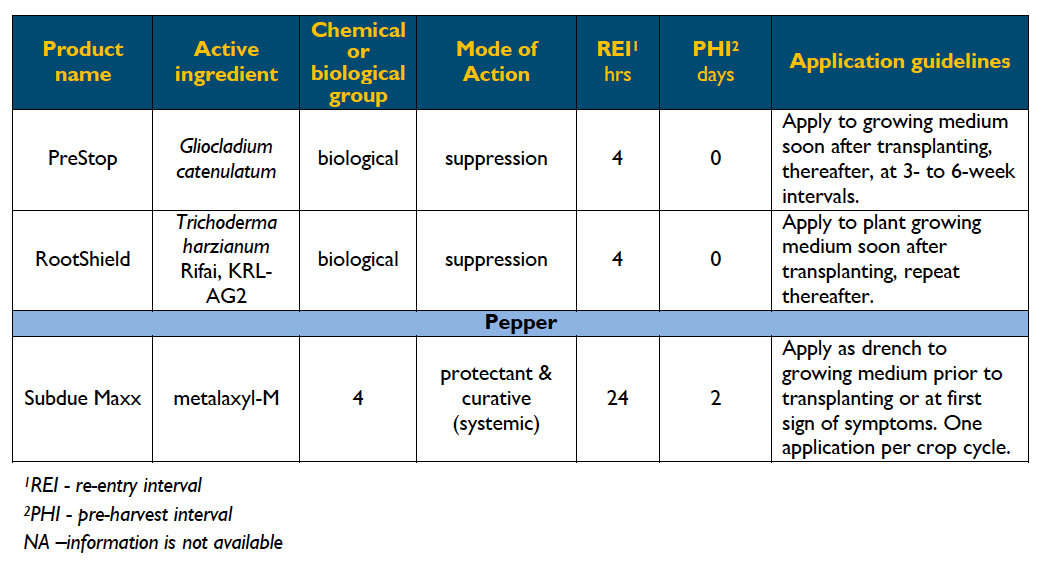
Features
Crop Protection
Inputs
Pythium management in greenhouse vegetables
March 18, 2019 By BC Ministry of Agriculture
 Figure 1. Pythium crown and root rot in greenhouse cucumber showing orange discolouration of the crown area (left) and rotted roots and root tips (right).
Figure 1. Pythium crown and root rot in greenhouse cucumber showing orange discolouration of the crown area (left) and rotted roots and root tips (right). Pythium species are fungal-like organisms (Oomycetes), commonly referred to as water molds, which naturally exist in soil and water as saprophytes, feeding on organic matter. Some Pythium species can cause serious diseases on greenhouse vegetable crops resulting in significant crop losses.
Pythium infection leads to damping-off in seedlings and crown and root rot of mature plants. In Canada, several Pythium species, including P. aphanidermatum, P. irregulare and P. ultimum, are known to cause damping-off and crown and root rot in greenhouse cucumber, pepper and tomato crops. There are no Pythium-resistant varieties available, although some varieties may have disease tolerance.
Overwatering, poor root aeration, root injury and improper root zone temperatures can weaken the crop and trigger Pythium outbreaks. Saturated growing media that are either too cold or too warm can be conducive to Pythium build up and spread in water and recirculating nutrient solution. Plants grown under optimal environmental conditions are less susceptible to Pythium than plants grown under poor conditions.
Disease cycle
Pythium can be introduced into a greenhouse in plug transplants, soil, growing media, plant refuse and irrigation water. Greenhouse insects such as fungus gnats (Bradysia impatiens) and shore flies (Scatella stagnalis) can also carry and spread Pythium.
Pythium spreads by forming sporangia, sack-like structures, that each release hundreds of swimming zoospores. Zoospores that reach the plant root surface encyst, germinate and colonize the root tissue by producing fine thread-like structures of hyphae, collectively called mycelium. These hyphae release hydrolytic enzymes that degrade root tissue and absorb nutrients as a food source. Pythium forms oospores and chlamydospores on decaying plant roots which can survive prolonged adverse conditions in soil, greenhouse growing media and water, leading to subsequent infections.
Symptoms
‘Pre-emergence’ damping-off causes seeds and young seedlings to rot before they emerge from the growing medium, while ‘post-emergence’ damping off kills newly emerged seedlings.
In ‘post-emergence’ damping-off, the pathogen causes a water-soaked, soft brown lesion at the stem base, near the soil line, that pinches off the stem causing the seedling to topple over and die. In mature plants, Pythium causes crown and root rot, where plants suddenly wilt when weather turns warm and sunny and when plants have their first heavy fruit load. Often, upper leaves of infected plants wilt in the day and recover overnight but plants eventually die.
In the root system, initial symptoms appear as brown to dark-brown lesions on root tips and feeder roots. As the disease progresses, symptoms of soft, brown stubby roots and lacking feeder roots, become visible (Figure 1). In larger roots, the outer root tissue or cortex peels away leaving the string-like vascular bundles underneath.
Pythium rot also occurs in the crown tissue at the stem base. In cucumber, diseased crowns turns orange-brown in colour, often with a soft rot at the base; brownish lesions extending 10 cm up the stem base may be seen.
Monitoring & Identification
Routinely monitor your crop for slightly wilted plants and check wet areas in the greenhouse where Pythium is more likely to be present. Pythium occurs mostly in spring, at early fruit set and later in the season on mature plants.
In cucumber, Pythium can also occur in the summer on young plants brought in for the fall crop. Monitor plants for wilting, and in cucumber, check the stem bases for discoloration. Always confirm Pythium diseases by sending representative plant samples with roots, crowns and foliage to a plant diagnostic laboratory or the local ministry of agriculture’s plant health laboratory.
Integrated Disease Management
Disease management consists of a combination of cultural, biological and chemical tools to control and/or manage crop diseases effectively. Cultural controls keep Pythium from reaching the roots while biological and chemical controls inhibit or suppress Pythium in the root zone.
Cultural Controls
Sanitation: Field soil, debris, irrigation water from pond and stream water, roots, and plant refuse and growing medium of previous crops can contain Pythium. Follow a strict greenhouse sanitation program throughout the year and a thorough year-end clean up. Clean and disinfest all interior greenhouse surfaces and equipment including tools, hoses, walkways, carts, totes, troughs, tanks and water supply lines. Use sterile propagating media. Remove dying plants by placing them directly into plastic bags for disposal away from the greenhouse.
Irrigation water: Untreated water from rivers, streams or ponds poses great risk for Pythium introduction while treated, municipal water is considered safe from Pythium. Water storage and nutrient tanks need to be disinfected periodically and covered to prevent Pythium contamination.
Nutrient Solution: Generally, greenhouse vegetables are raised on rockwool in plastic sleeves or bags containing rooting medium (i.e. rockwool slabs, sawdust or coconut fibre) through which water and nutrient solution are circulated. Since Pythium and other pathogens can build up in nutrient solution, periodically disinfest recirculating nutrient solution using physical, biological or chemical methods (Marchuk, 2006).
Resistant varieties: Although there are no resistant vegetable varieties, some vigorous varieties may have some tolerance to Pythium. Contact your local seed/transplant agent for further information on Pythium tolerant varieties.
Seedlings & Transplants: Carry out transplanting in the morning or late afternoon/evening to avoid stress from high day time temperatures. Allow for good air circulation around seedlings by proper plant spacing and good aeration of irrigation water and re-circulating nutrient solution. Use healthy transplants and handle them carefully to avoid wounding plants and roots and practice good sanitation when transplanting; do not let them dry when setting out. Water seedlings in the morning so that plants are not wet overnight.
Plant growing conditions: Ensure that transplants have the proper root zone temperature and adequate moisture when moved into the greenhouse. The growing media must be well drained, as saturated bags with low oxygen levels can predispose transplants to Pythium diseases.
Use warm, aerated irrigation water (18-22°C). Avoid low light levels, low pH, high salts and warm growing conditions (above 28°C) which favour Pythium. In greenhouse cucumbers, the nutrient solution should be delivered at pH 5.0 for approximately 5 weeks followed by adjusting the pH to a 5.8-6.2 regime for one week. (Tu, 2004).
Target rockwool block wetness at 70-75% between watering.
Use white/colourless drip lines instead of black or place drip lines on the shaded side of the grow bags.
Disease monitoring: Plants must be monitored for any signs of Pythium diseases throughout the cropping cycle. Remove and destroy severely infected plants and replant in new growing bags medium. Infected plant materials, including grow bags, must be safely disposed away from the greenhouse by deep-burying, incinerating or composting.
Control fungus gnats (Bradysia impatiens) and shore flies (Scatella stagnalis) which spread Pythium.
Biological and Chemical Control
Prevent Pythium diseases by practicing integrated disease management strategies based on cultural and biological controls. Use fungicides as a last resort at the onset of disease.
Rotate registered fungicides with different chemical groups and strictly follow label directions to avoid resistance development in Pythium.
Routinely monitor plants and evaluate the level of disease control if fungicides are used. Stop fungicide treatment and get professional advice if fungicides fail.

For Further Information
• Cherif, M. et.al. 1994. Defense responses induced by soluble silicon in cucumber roots infected by Pythium spp. Phytopathology 84: 236-242.
• Compendium of pepper diseases. 2003. K. Pernezny, et. al. editors. The American Phytopathological Society. http://www.apsnet.org/apsstore/shopapspress/Pages/43003.aspx
• Diseases and pests of vegetable crops in Canada. 1994. R. Howard et. al. editors. The Canadian Phytopathological Society and the Entomological Society of Canada.
• Growing greenhouse peppers in British Columbia. A production guide for commercial growers. 2005. BC Greenhouse Growers’ Association and B.C. Ministry of Agriculture. http://bcgreenhouse.ca/
• Growing greenhouse vegetables. 2005. Ontario Ministry of Agriculture, Food and Rural Affairs. Publication order #371, Agdex #290. http://www.omafra.gov.on.ca/english/products/newpubs.html or products@omaf.gov.on.ca
• Jarvis, W.R. 1992. Managing diseases in greenhouse crops. American Phytopathological Society. http://www.apsnet.org/apsstore/shopapspress/Pages/41221.aspx
• Marchuk, R. 2006. Treatments for greenhouse recirculation water. Proceedings, 48th Annual Horticulture Growers Short Course, 2006. Lower Mainland Horticultural Improvement Association, Pages 3-8.
• Pesticide label information for Canada: http://pr-rp.hc-sc.gc.ca/ls-re/index-eng.php
• Tu, J. C. 2004. An integrated control measure for Pythium root rot of hydroponically grown greenhouse cucumbers. Acta Horticulturae 644: 571-574.
• Zamir, P.K. and R. Yip. 2003. Biological control of damping off and root rot caused by Pythium aphanidermatum on greenhouse cucumbers. Can. J. Plant Pathol. 25: 411-417.
Updated by:
Siva Sabaratnam,
Plant Pathologist,
British Columbia Ministry of Agriculture
Abbotsford, B.C.
Original, printer-friendly pdf version here: Fact Sheet
Print this page